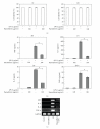The traditional Japanese formula keishibukuryogan inhibits the production of inflammatory cytokines by dermal endothelial cells
- PMID: 21253500
- PMCID: PMC3021874
- DOI: 10.1155/2010/804298
The traditional Japanese formula keishibukuryogan inhibits the production of inflammatory cytokines by dermal endothelial cells
Abstract
Keishibukuryogan (KBG) is one of the traditional herbal formulations widely administered to patients with blood stagnation for improving blood circulation; currently, it is the most frequently prescribed medicine in Japan. KBG has been reported to improve conjunctional microcirculation. The aim of this study was to evaluate the role of KBG and paeoniflorin, a bioactive compound of KBG, in inhibiting the production of inflammatory cytokines using human dermal microvessel endothelial cells (HDMECs). The authors observed that lipopolysaccharide (LPS; 1 μg/mL) stimulated the secretion of proinflammatory cytokines in HDMECs. KBG treatment (10 mg/mL) significantly suppressed the mRNA levels of migration inhibitory factor (MIF), interleukin (IL)-6, IL-8, and tumor necrosis factor (TNF)-α in LPS-stimulated cultured HDMECs. Similarly, paeoniflorin significantly suppressed the mRNA levels of these cytokines in LPS-stimulated cultured HDMECs. ELISA showed that KBG and paeoniflorin suppressed the production of MIF, IL-6, IL-8, and TNF-α in LPS-stimulated HDMECs. Moreover, KBG and paeoniflorin decreased the expression of cyclooxygenase-2 and inducible nitric oxide synthase (iNOS) in these cells. These results suggest that KBG may be useful for improving microvascular inflammation in patients with skin diseases.
Figures



Similar articles
-
A Review on the Mechanism and Application of Keishibukuryogan.Front Nutr. 2021 Dec 24;8:760918. doi: 10.3389/fnut.2021.760918. eCollection 2021. Front Nutr. 2021. PMID: 35004802 Free PMC article. Review.
-
Ethanol extract from a Chinese herbal formula, "Zuojin Pill", inhibit the expression of inflammatory mediators in lipopolysaccharide-stimulated RAW 264.7 mouse macrophages.J Ethnopharmacol. 2012 May 7;141(1):377-85. doi: 10.1016/j.jep.2012.02.049. Epub 2012 Mar 6. J Ethnopharmacol. 2012. PMID: 22414473
-
Amelioration of Danhong injection on the lipopolysaccharide-stimulated systemic acute inflammatory reaction via multi-target strategy.J Ethnopharmacol. 2013 Oct 7;149(3):772-82. doi: 10.1016/j.jep.2013.07.039. Epub 2013 Aug 14. J Ethnopharmacol. 2013. PMID: 23954279
-
Cilostazol inhibits the expression of hnRNP A2/B1 and cytokines in human dermal microvascular endothelial cells.Clin Exp Rheumatol. 2017 Nov-Dec;35 Suppl 108(6):60-66. Epub 2017 Aug 28. Clin Exp Rheumatol. 2017. PMID: 28850024
-
Effects of compounds from bi-qi capsule on the expression of inflammatory mediators in lipopolysaccharide-stimulated RAW 264.7 macrophages.J Ethnopharmacol. 2011 Jul 14;136(3):480-7. doi: 10.1016/j.jep.2010.06.008. Epub 2010 Jun 15. J Ethnopharmacol. 2011. PMID: 20558268
Cited by
-
Preparation and Chromatographic Application of β-Cyclodextrin Molecularly Imprinted Microspheres for Paeoniflorin.Polymers (Basel). 2017 Jun 9;9(6):214. doi: 10.3390/polym9060214. Polymers (Basel). 2017. PMID: 30970892 Free PMC article.
-
Effective Use of Keishibukuryogan in Subcutaneous Hematoma after Implantable Cardiac Device Surgery in Two Cases.Intern Med. 2021 Mar 1;60(5):755-759. doi: 10.2169/internalmedicine.5677-20. Epub 2020 Oct 7. Intern Med. 2021. PMID: 33028772 Free PMC article.
-
Efficacy of kampo medicine in treating atopic dermatitis: an overview.Evid Based Complement Alternat Med. 2013;2013:260235. doi: 10.1155/2013/260235. Epub 2013 Dec 29. Evid Based Complement Alternat Med. 2013. PMID: 24639879 Free PMC article. Review.
-
A Review on the Mechanism and Application of Keishibukuryogan.Front Nutr. 2021 Dec 24;8:760918. doi: 10.3389/fnut.2021.760918. eCollection 2021. Front Nutr. 2021. PMID: 35004802 Free PMC article. Review.
-
Identifying Chinese Herbal Medicine Network for Endometriosis: Implications from a Population-Based Database in Taiwan.Evid Based Complement Alternat Med. 2017;2017:7501015. doi: 10.1155/2017/7501015. Epub 2017 Jun 27. Evid Based Complement Alternat Med. 2017. PMID: 28740539 Free PMC article.
References
-
- Itoh T, Terasawa K, Kohta K, Shibahara N, Tosa H, Hiyama Y. Effects of Keishi-bukuryo-gan and Trapidil on the microcirculation in patients with cerebro-spinal vascular disease. Journal of Medical and Pharmaceutical Society for WAKAN-YAKU. 1992;9:40–46.
-
- Hikiami H, Goto H, Sekiya N, et al. Comparative efficacy of Keishi-bukuryo-gan and pentoxifylline on RBC deformability in patients with "oketsu" syndrome. Phytomedicine. 2003;10(6-7):459–466. - PubMed
-
- Kohta K, Hikiami H, Shimada Y, Matsuda H, Hamazaki T, Terasawa K. Effects of Keishi-bukuryo-gan on erythrocyte aggregability in patients with multiple old lacunar infarction. Journal of Medical and Pharmaceutical Society for WAKAN-YAKU. 1993;10:251–259.
-
- Tosa H, Toriizuka K, Terasawa K. The effect of Keishi-bukuryogan on blood viscosity and blood coagulation in normal subjects. Journal of Medical and Pharmaceutical Society for WAKAN-YAKU. 1987;4:172–179.
Publication types
MeSH terms
Substances
LinkOut - more resources
Full Text Sources
Research Materials
Miscellaneous

